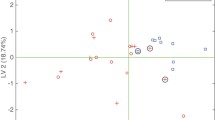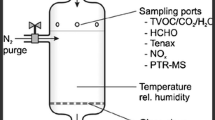Abstract
There has been growing interest in exhaled breath analysis for cancer screening and disease monitoring; however, limited breath biomarker information exists regarding colorectal cancer (CRC). The objective of this study was to screen for breath biomarkers of CRC. Exhaled breath was collected from 20 CRC patients and 20 healthy controls; subsequently, solid-phase microextraction–gas chromatography/mass spectrometry (SPME-GC/MS) was used to assess the exhaled volatile organic compounds (VOCs) of the study participants. The statistical methods of principal component analysis (PCA) and partial least squares discriminant analysis (PLS-DA) were performed to process the final data. The VOCs in the exhalations of CRC patients exhibited significant differences from the VOCs in the exhalations of healthy controls; in particular, relative to the latter exhalations, the former exhalations contain significantly higher levels of cyclohexanone, 2,2-dimethyldecane, dodecane, 4-ethyl-1-octyn-3-ol, ethylaniline, cyclooctylmethanol, trans-2-dodecen-1-ol, and 3-hydroxy-2,4,4-trimethylpentyl 2-methylpropanoate but significantly lower levels of 6-t-butyl-2,2,9,9-tetramethyl-3,5-decadien-7-yne (P < 0.05). Analyses of breath VOCs provide a related model of CRC exhalation that could represent an effective and convenient screening method for this disease.

Partial least-squares discriminant analysis scores plot (with the three components of R2X=0.583, R2Y=0.806, and Q2=0.565), which reveals that a considerable separation was achieved between colorectal cancer breath samples and normal controls



Similar content being viewed by others
References
Kim HJ, Yu MH, Kim H, Byun J, Lee C (2008) Non invasive molecular biomarkers for the detection of colorectal cancer. BMB Rep 41:685–692
Siegel R, DeSantis C, Virgo K, Stein K, Mariotto A, Smith T, Cooper D, Gansler T, Lerro C, Fedewa S, Lin C, Leach C, Cannady RS, Cho H, Scoppa S, Hachey M, Kirch R, Jemal A, Ward E (2012) Cancer treatment and survivorship statistics, 2012. CA Cancer J Clin 62:220–241
Bingham S, Riboli E (2004) Diet and cancer—the European Prospective Investigation into Cancer and Nutrition. Nat Rev Cancer 4:206–215
Mandel JS, Church TR, Bond JH, Ederer F, Geisser MS, Mongin SJ, Snover DC, Schuman LM (2000) The effect of fecal occult-blood screening on the incidence of colorectal cancer. N Engl J Med 343:1603–1607
Fletcher RH (1986) Carcinoembryonic antigen. Ann Intern Med 104:66–73
Kronborg O, Fenger C, Olsen J et al (1996) Randomised study of screening for colorectal cancer with faecal-occult-blood test. Lancet 348:1467–1471
Winawer SJ, Zauber AG, Ho MN, Jørgensen OD, Søndergaard O, The National Polyp Study Workgroup (1993) Prevention of colorectal cancer by colonoscopic polypectomy. N Engl J Med 329:1977–1981
Phillips M, Cataneo RN, Cummin AR, Gagliardi AJ, Gleeson K, Greenberg J, Maxfield RA, Rom WN (2003) Detection of lung cancer with volatile markers in the breath. Chest 123:2115–2123
Gordon SM, Szidon JP, Krotoszynski BK, Gibbons RD, O'Neill HJ (1985) Volatile organic compounds in exhaled air from patients with lung cancer. Clin Chem 31:1278–1282
Hietanen E, Bartsch H, Béréziat JC, Camus AM, McClinton S, Eremin O, Davidson L, Boyle P (1994) Diet and oxidative stress in breast, colon and prostate cancer patients: a case-control study. Eur J Clin Nutr 48:575–586
Altomare DF, Di Lena M, Porcelli F, Trizio L, Travaglio E, Tutino M, Dragonieri S, Memeo V, de Gennaro G (2013) Exhaled volatile organic compounds identify patients with colorectal cancer. Br J Surg 100:144–150
Xu ZQ, Broza YY, Ionsecu R, Tisch U, Ding L, Liu H, Song Q, Pan YY, Xiong FX, Gu KS, Sun GP, Chen ZD, Leja M, Haick H (2013) A nanomaterial-based breath test for distinguishing gastric cancer from benign gastric conditions. Br J Cancer 108:941–950
Barash O, Peled N, Tisch U, Bunn PA Jr, Hirsch FR, Haick H (2012) Classification of lung cancer histology by gold nanoparticle sensors. Nanomedicine 8:580–589
Chen X, Xu F, Wang Y, Pan Y, Lu D, Wang P, Ying K, Chen E, Zhang W (2007) A study of the volatile organic compounds exhaled by lung cancer cells in vitro for breath diagnosis. Cancer 110:835–844
Peng G, Hakim M, Broza YY, Billan S, Abdah-Bortnyak R, Kuten A, Tisch U, Haick H (2010) Detection of lung, breast, colorectal, and prostate cancers from exhaled breath using a single array of nanosensors. Br J Cancer 103:542–551
Birken T, Schubert J, Miekisch W, Nöldge-Schomburg G (2006) A novel visually CO2 controlled alveolar breath sampling technique. Technol Health Care 14:499–506
Miekisch W, Kischkel S, Sawacki A, Liebau T, Mieth M, Schubert JK (2008) Impact of sampling procedures on the results of breath analysis. J Breath Res 2:026007
Bajtarevic A, Ager C, Pienz M, Klieber M, Schwarz K, Ligor M, Ligor T, Filipiak W, Denz H, Fiegl M, Hilbe W, Weiss W, Lukas P, Jamnig H, Hackl M, Haidenberger A, Buszewski B, Miekisch W, Schubert J, Amann A (2009) Noninvasive detection of lung cancer by analysis of exhaled breath. BMC Cancer 9:348
Lin HM, Edmunds SJ, Helsby NA, Ferguson LR, Rowan DD (2009) Non-targeted urinary metabolite profiling of a mouse model of Crohn’s disease. J Proteome Res 8:2045–2057
Gao X, Pujos-Guillot E, Martin JF, Galan P, Juste C, Jia W, Sebedio JL (2009) Metabolite analysis of human fecal water by gas chromatography/mass spectrometry with ethyl chloroformate derivatization. Anal Biochem 393:163–175
Katajamaa M, Oresic M (2007) Data processing for mass spectrometry-based metabolomics. J Chromatogr A 1158:318–328
Trygg J, Holmes E, Lundstedt T (2007) Chemometrics in metabonomics. J Proteome Res 6:469–479
Westerhuis JA, Hoefsloot HCJ, Smit S, Vis DJ, Smilde AK, Velzen EJJ, Duijnhoven JPM, Dorsten FA (2008) Assessment of PLSDA cross validation. Metabolomics 4:81–89
Benjamini Y, Hochberg Y (1995) Controlling the false discovery rate: apractical and powerful approach to multiple testing. J R Stat Soc Ser 29:1165–1188
Storey JD (2003) The positive false discovery rate: a Bayesian interpretation and the q-value. Ann Stat 31:2013–2035
Miekisch W, Schubert JK, Noeldge-Schomburg GF (2004) Diagnostic potential of breath analysis—focus on volatile organic compounds. Clin Chim Act 347:25–39
Hassanein M, Callison JC, Callaway-Lane C, Aldrich MC, Grogan EL, Massion PP (2012) The state of molecular biomarkers for the early detection of lung cancer. Cancer Prev Res (Phila) 5:992–1006
Li J, Peng Y, Duan Y (2012) Diagnosis of breast cancer based on breath analysis: an emerging method. Crit Rev Oncol Hematol 19:S1040–S8428
Phillips M, Cataneo RN, Saunders C, Hope P, Schmitt P, Wai J (2010) Volatile biomarkers in the breath of women with breast cancer. J Breath Res 4:026003, 30
Carpagnano GE, Palladino GP, Martinelli D, Lacedonia D, Orlando S, Foschino-Barbaro MP (2012) Exhaled matrix metalloproteinase-9 in lung cancer. Rejuvenation Res 15:359–365
Filipiak W, Sponring A, Mikoviny T, Ager C, Schubert J, Miekisch W, Amann A, Troppmair J (2008) Release of volatile organic compounds (VOCs) from the lung cancer cell line CALU-1 in vitro. Cancer Cell Int 8:17
Acknowledgments
Financial support by grants from the National Natural Science Foundation of China (No. 30972839), China Postdoctoral Science Foundation (No. 2013M531069), Foundation of Heilongjiang Educational Committee (No. 12531245), and Doctoral Fund of the First Affiliated Hospital of Harbin Medical University (No. 2012B006) are gratefully acknowledged.
Author information
Authors and Affiliations
Corresponding author
Additional information
Changsong Wang and Chaofu Ke contributed equally to this work.
Rights and permissions
About this article
Cite this article
Wang, C., Ke, C., Wang, X. et al. Noninvasive detection of colorectal cancer by analysis of exhaled breath. Anal Bioanal Chem 406, 4757–4763 (2014). https://doi.org/10.1007/s00216-014-7865-x
Received:
Revised:
Accepted:
Published:
Issue Date:
DOI: https://doi.org/10.1007/s00216-014-7865-x




